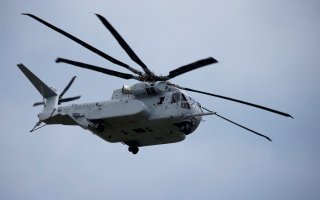The U.S. Navy Will Soon Get Its First CH-53K “King Stallion” Helicopters
Much heavier lift helicopters bring new tactical dimensions to both expeditionary and maritime warfare as they enable more dispersed operations.
Here's What You Need to Know: These heavy lift helicopters will help deploy Marines and supplies across the Pacific.
The Navy has ordered its first six heavy-lift CH-53K helicopters, a move which bring much greater cargo, supply and troop-carrying capacity to amphibious warfare as the helicopters operate from both land as well as amphibious assault ships.
The “K” model CH-53 is engineered to provide more lift, speed, performance and protection compared to prior models.
The idea with the helicopter is to engineer a new aircraft with much greater performance and three-times the lift capacity compared to the existing CH-53E or “Echo” model aircraft designed in the 1980’s, Navy weapons developers said.
Earlier in the development of the CH-53K, Marine Corps program managers said the requirement for the new helicopters is to be able to lift 27,000 pounds, take it 110 nautical miles, stay 30 minutes on station and then be able to return to a ship under high hot conditions. This lift capacity is three-times the 9,000-pound lift ability of the existing Echo model.
Higher temperatures and higher altitudes create a circumstance wherein the decreased air-pressure makes it more difficult for helicopters to fly and carry payloads.
The initial requirement for the “K” model CH-53 emerged out of the need to build a variant with much more lift. a Marine Corps study which looked at the combat aviation elements of a Marine Air-Ground Task Force (MAGTF).
Engineers with the “K” program are using a handful of new technologies to achieve greater lift, speed and performance with the helicopter, including the integration of a new, more powerful GE T408 turboshaft engine for the aircraft, developers explained.
The helicopter is also being built with lighter-weight composite materials for the airframe and the rotorblades, materials able to equal or exceed the performance of traditional metals at a much lighter weight, Sikorsky and Navy developers explained.
Earlier in the CH-53K’s development, Sikorsky weapons developers said the design involves an all-composite skinned airframe, fourth generation rotorblades and a combination of new airfolds, taper, integrated cuff and modified tip deflection of the blade.
The helicopter will also be configured with Infrared Countermeasures, a high-tech laser-jammer designed to throw incoming missiles off course.
Also, the CH-53 K uses what developers refer to as a split-torque transmission design that transfers high-power, high-speed engine output to lower-speed, high-torque rotor drive in a weight efficient manner.
The K model is a “fly by wire” capable helicopter and also uses the latest in what’s called conditioned-based maintenance, a method wherein diagnostic sensors are put in place to monitor systems on the aircraft in order to better predict and avert points of mechanical failure.
The Marine Corps has a requirement for 200 CH-53Ks, SeaPower Magazine said.
Much heavier lift helicopters bring new tactical dimensions to both expeditionary and maritime warfare as they enable more dispersed operations. Forward-operating otherwise disconnected force concentrations can be resupplied with supplies, weapons and ammunition by heavier helicopter transportation loads, changing the tactical equation. A combat outpost in an island area in the Pacific can more easily receive reinforcements from amphibiously launched, heavy lift helicopters able to bring much greater supply loads per mission. A CH-53K would also be better positioned to, for instance, sling load mobile artillery weapons or even light tactical vehicles into high-risk land combat areas as well.
Kris Osborn is the defense editor for the National Interest. Osborn previously served at the Pentagon as a Highly Qualified Expert with the Office of the Assistant Secretary of the Army—Acquisition, Logistics & Technology. Osborn has also worked as an anchor and on-air military specialist at national TV networks. He has appeared as a guest military expert on Fox News, MSNBC, The Military Channel, and The History Channel. He also has a Masters Degree in Comparative Literature from Columbia University.
This article first appeared earlier this year.
Image: Reuters

